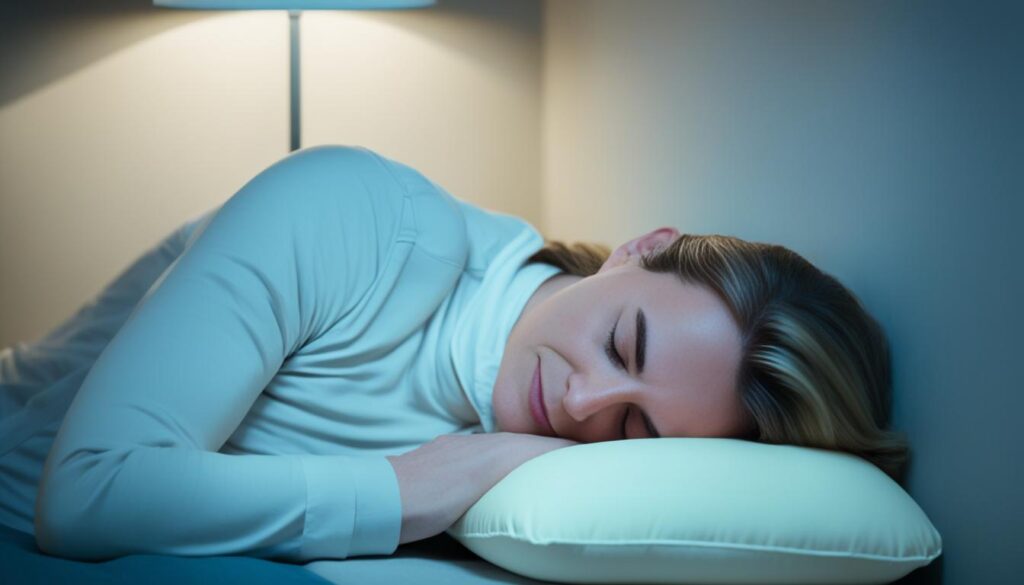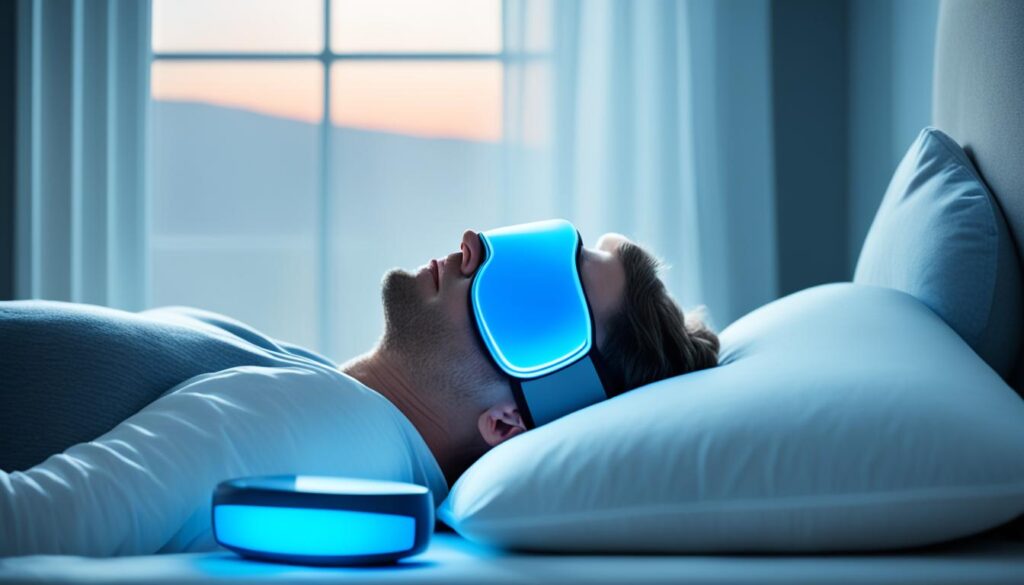Have you ever experienced a throbbing pain at the base of your skull that radiates toward your eyes? The sharp, debilitating sensation that seems to worsen when you’re lying down, making it almost impossible to find a comfortable position to sleep? I’ve been there, and let me tell you, it’s frustrating beyond words.
When I was diagnosed with occipital neuralgia, I felt like my world was turned upside down. Simple everyday activities like sleeping became a constant battle against the relentless pain. I spent nights tossing and turning, trying to find the best way to sleep that would alleviate the excruciating discomfort. It seemed like an endless quest.
But through research, trial and error, and the guidance of healthcare professionals, I discovered strategies and techniques that have made a world of difference in my sleep quality and pain management. And now, I want to share them with you.
In this article, we’ll explore the best way to sleep with occipital neuralgia and provide you with valuable insights on sleep positions, pillows, natural remedies, and sleep aids that can help alleviate pain and ensure restful nights. Together, we can find a path to better sleep and relief from the challenges imposed by occipital neuralgia.
Key Takeaways
- Experiment with different sleep positions to find the most comfortable one for your occipital neuralgia.
- Invest in a supportive pillow that provides proper neck alignment and minimizes strain on the nerves.
- Consider natural remedies such as heat therapy and beneficial supplements to enhance sleep quality.
- Explore sleep aids and assistive devices tailored for occipital neuralgia sufferers.
- Seek medical intervention if your occipital neuralgia symptoms worsen or persist despite self-care strategies.
Understanding Occipital Neuralgia and Its Impacts on Sleep
Occipital neuralgia is a condition characterized by intense, throbbing pain in the occipital nerves, which run from the base of the skull to the scalp. This pain can be debilitating and impact various aspects of daily life, including sleep. Understanding the symptoms, causes, and treatment options for occipital neuralgia is essential in managing its impact on sleep quality.
Occipital Neuralgia Symptoms:
- Severe, sharp or stabbing pain in the back of the head and neck
- Pain radiating to the forehead, temples, and behind the eyes
- Tenderness or sensitivity in the scalp
- Pain triggered by neck movement or pressure on the occipital nerves
Occipital Neuralgia Causes:
- Compression or irritation of the occipital nerves
- Trauma or injury to the head or neck
- Neck muscle tension or spasms
- Nerve inflammation or damage
Occipital Neuralgia Treatment:
- Medications to relieve pain and reduce inflammation
- Physical therapy to improve muscle function and reduce nerve irritation
- Nerve blocks or local anaesthetic injections to alleviate pain
- Supplementary therapies, such as acupuncture or massage
Occipital neuralgia can significantly impact sleep quality. The constant pain and discomfort can make it difficult to find a comfortable sleep position. Furthermore, the pain may worsen at night, leading to disrupted sleep patterns and frequent awakenings. Addressing occipital neuralgia’s impact on sleep is crucial for restoring restful nights and improving overall well-being.
Navigating Sleep Positions for Optimal Comfort
When it comes to managing occipital neuralgia pain during sleep, finding the right sleep position is essential. Different sleep positions can provide relief and minimize discomfort. In this section, we will explore three key aspects of sleep positions for occipital neuralgia: supine sleeping, adjusting pillows for enhanced support, and maintaining proper neck alignment.
Finding Relief with Supine Sleeping
Supine sleeping, or sleeping on your back, is often recommended for individuals with occipital neuralgia. This position helps distribute weight evenly and minimizes pressure on the neck and head. To optimize supine sleeping, use a supportive pillow that cradles your neck and aligns your spine. This can help reduce strain on the occipital nerves and alleviate pain.
Adjusting Pillows for Enhanced Support
The right pillow can make a significant difference in promoting comfort and reducing occipital neuralgia pain while sleeping. Use a pillow that provides adequate support for your neck and head. Consider using a contoured or cervical pillow designed to maintain proper alignment. Experiment with different pillow heights and firmness levels to find the optimal combination for your individual needs.
Minimizing Neck Strain Through Alignment
Proper neck alignment is crucial for individuals with occipital neuralgia. When lying on your side, make sure your pillow fills the gap between your neck and shoulder, maintaining a straight alignment. Avoid using pillows that are too soft or too high, as they can strain the neck and exacerbate pain. When lying on your back, ensure that your head is well-supported by a pillow that keeps your neck in a neutral position.
By understanding and implementing these techniques, you can enhance comfort and alleviate occipital neuralgia pain during sleep. Experiment with different sleep positions, pillows, and neck alignment strategies to find what works best for you.
The Relationship Between Sleep Hygiene and Occipital Neuralgia
Sleep hygiene plays a critical role in managing occipital neuralgia symptoms and improving overall sleep quality. By incorporating good sleep habits into your daily routine, you can minimize discomfort and maximize restfulness during sleep.
Here are some practical tips and strategies for improving sleep hygiene with occipital neuralgia:
- Create a consistent sleep schedule: Go to bed and wake up at the same time every day, even on weekends. This helps regulate your body’s internal clock and promotes better quality sleep.
- Establish a relaxing bedtime routine: Engage in soothing activities such as reading a book, taking a warm bath, or practising relaxation exercises before bed. This helps signal to your body that it’s time to wind down and prepares you for a restful night’s sleep.
- Create a sleep-friendly environment: Make sure your bedroom is cool, dark, and quiet. Use curtains or blinds to block out any external light and consider using earplugs or a white noise machine to drown out any disturbing noises.
- Avoid stimulating activities before bed: Limit your exposure to electronic devices such as smartphones, tablets, and computers in the evening, as the blue light emitted from these devices can interfere with your sleep. Instead, opt for relaxing activities that promote sleepiness.
- Exercise regularly: Engaging in regular physical activity can help regulate your sleep-wake cycle and promote deeper, more restorative sleep. Just make sure to finish your workout at least a few hours before bedtime to allow your body to cool down.
- Manage stress: Stress can worsen occipital neuralgia symptoms and disrupt your sleep. Explore stress management techniques such as meditation, deep breathing exercises, and journaling to help alleviate stress and promote relaxation.
- Avoid stimulants: Limit your consumption of caffeine and avoid it altogether in the evening. Caffeine is a stimulant that can interfere with your sleep and increase the intensity of occipital neuralgia pain.
- Create a comfortable sleep environment: Invest in a supportive mattress and consider using pillows that provide proper neck support. Finding the right sleep accessories can help minimize pressure on the occipital nerves and reduce discomfort.
By incorporating these sleep hygiene practices into your daily routine, you can significantly improve your sleep quality and reduce occipital neuralgia-related discomfort during sleep.
Best Way To Sleep With Occipital Neuralgia
Sleeping with occipital neuralgia can be challenging due to the pain and discomfort it causes. However, there are strategies you can follow to achieve a more comfortable and restful sleep. In this section, we will discuss key considerations for reducing pressure on the nerves and provide tips for strategic sleep positioning to combat the pain associated with occipital neuralgia.
Key Considerations for Reducing Pressure on Nerves
Reducing pressure on the nerves is essential for alleviating occipital neuralgia-related discomfort during sleep. Here are some key considerations to keep in mind:
- Choose a pillow that provides adequate support for your head and neck. Opt for pillows that are firm yet comfortable, as they can help maintain proper spinal alignment and reduce pressure on the nerves.
- Ensure your mattress is supportive and provides the right level of firmness. A mattress that is too soft or sagging can increase pressure on the nerves, exacerbating the pain of occipital neuralgia.
- Experiment with different sleep positions to find one that minimizes pressure on the affected area. For some individuals, sleeping on their back with a pillow supporting the neck and head may provide relief. Others may find sleeping on their side with a pillow between the knees beneficial.
Combating Pain with Strategic Sleep Positioning
Strategic sleep positioning can help alleviate pain and discomfort caused by occipital neuralgia. Consider the following tips:
- Elevate your head slightly using a pillow or an adjustable bed to relieve pressure on the nerves.
- Avoid sleeping on your stomach, as this can strain the neck and exacerbate occipital neuralgia pain. Instead, try sleeping on your back or side.
- If sleeping on your side, consider using a body pillow to support your neck and maintain proper spinal alignment.
- Experiment with different pillow positions to find the one that provides the most relief. Some individuals find that placing a pillow under the neck or using a contoured neck pillow can help reduce pain.
To sum up, reducing nerve pressure during sleep and strategically positioning yourself can greatly improve your sleep quality with occipital neuralgia. By following these tips, you can find the best way to sleep with occipital neuralgia and wake up feeling more refreshed and pain-free.

Choosing the Right Pillow for Occipital Neuralgia Sufferers
When it comes to managing occipital neuralgia-related discomfort during sleep, selecting the right pillow is crucial. It plays a significant role in providing adequate support and alleviating pain. In this section, we will compare two popular pillow options, memory foam, and latex, and emphasize the importance of pillow breathability for enhanced sleep comfort.
Memory Foam vs. Latex Options
Memory foam pillows have gained popularity for their ability to conform to the shape of the head and neck, providing personalized support. This can be particularly beneficial for individuals with occipital neuralgia, as the pillow molds to the contours, helping alleviate pressure on the affected areas. Latex pillows, on the other hand, offer a resilient and supportive surface, providing consistent neck support throughout the night. Both options have their advantages, so it’s essential to consider personal preferences and the level of support needed.
The Importance of Pillow Breathability
Pillow breathability is a crucial factor to consider for individuals with occipital neuralgia. Proper airflow and ventilation can help regulate temperature and prevent excessive heat buildup, enabling a more comfortable sleep experience. Look for pillows that are made with breathable materials such as cotton or bamboo, which are known for their moisture-wicking properties. Additionally, pillows with perforations or ventilation channels can further enhance breathability.
Choosing the right pillow for occipital neuralgia can significantly impact sleep quality and pain management. Remember to consider your personal preferences, the level of support needed, and the pillow’s breathability when making a selection. By finding the perfect pillow, you can create a comfortable and supportive sleep environment to alleviate occipital neuralgia-related discomfort.
Exploring Sleep Aids and Assistive Devices
When it comes to managing occipital neuralgia and improving sleep quality, sleep aids and assistive devices can be valuable tools. These innovative products are designed to provide relief and promote restful sleep for individuals with occipital neuralgia. Let’s explore some of the options available in the market:

“Sleep aids and assistive devices can provide much-needed comfort and support for individuals with occipital neuralgia, enabling them to experience a better night’s sleep.”
1. Orthopedic Pillows: Orthopedic pillows are specifically designed to provide proper support and alignment for the head and neck. These pillows can help alleviate pain and pressure on the occipital nerves, allowing for a more comfortable sleeping position.
2. Neck Support Pillows: Neck support pillows are contoured to support the natural curve of the neck, providing optimal comfort and reducing strain on the occipital nerves. They can help improve sleep quality and alleviate occipital neuralgia-related discomfort.
3. Cooling Gel Pillows: Cooling gel pillows combine the benefits of a supportive pillow with the cooling properties of gel technology. These pillows can help regulate body temperature and provide soothing relief for individuals with occipital neuralgia.
4. Acoustic Relaxation Devices: Acoustic relaxation devices, such as white noise machines or calming sound apps, can create a soothing environment that promotes relaxation and masks any noise that may disrupt sleep. These devices can be particularly helpful for individuals with occipital neuralgia who are sensitive to sound.
5. Sleep Masks: Sleep masks can block out light and create a dark sleep environment, promoting deeper and more restful sleep. For people with occipital neuralgia, who may be sensitive to light, sleep masks can be a simple yet effective way to enhance sleep quality.
6. TENS Units: Transcutaneous Electrical Nerve Stimulation (TENS) units are small, portable devices that use electrical currents to provide pain relief. These devices can be applied to the occipital region during sleep to help manage occipital neuralgia-related pain.
These sleep aids and assistive devices are just a few examples of the options available to individuals with occipital neuralgia. It’s important to consult with a healthcare professional or specialist to find the right sleep aid or device that suits your specific needs and preferences.
By incorporating these sleep aids and assistive devices into your nightly routine, you can find relief from occipital neuralgia symptoms and enjoy a more restful and rejuvenating sleep experience.
Natural Remedies for Enhancing Sleep Quality Amidst Occipital Pain
Occipital neuralgia can disrupt sleep and cause discomfort throughout the night. In addition to adjusting sleep positions and using the right pillows, natural remedies can play a crucial role in enhancing sleep quality and alleviating pain. Beneficial supplements, such as vitamins, and heat therapy are two effective natural remedies that can provide relief for occipital neuralgia sufferers.
Beneficial Supplements: Vitamins for Occipital Neuralgia
Adding specific vitamins to your daily regimen can help improve sleep quality and manage occipital neuralgia symptoms. Here are some beneficial vitamins:
- Vitamin B12: Known for its nerve-supporting properties, vitamin B12 can help alleviate occipital neuralgia pain and promote better sleep.
- Vitamin D: Low levels of vitamin D are associated with increased pain sensitivity. Supplementing with vitamin D may help reduce occipital neuralgia-related discomfort during sleep.
- Magnesium: Known for its calming effects, magnesium can relax muscles and nerves, promoting better sleep and reducing occipital neuralgia pain.
Consult with your healthcare provider before incorporating any new supplements into your routine.
Heat Therapy and Its Soothing Effects
Heat therapy, also known as thermotherapy, can provide soothing relief for occipital neuralgia pain and improve sleep quality. Applying heat to the affected area can help relax tense muscles and increase blood flow, reducing discomfort and promoting relaxation. Try using a heating pad, or warm towel, or taking a warm shower before bed to enjoy the benefits of heat therapy.
Remember to use heat therapy safely and consult with your healthcare provider if you have any concerns or underlying medical conditions.
When and How to Seek Medical Intervention
While there are various strategies to manage occipital neuralgia symptoms on your own, there may come a time when seeking medical intervention becomes necessary. It is important to be aware of the signs that indicate the need for medical attention and the available treatment options for occipital neuralgia.
If you experience any of the following situations, it is advisable to consult a healthcare professional:
- Severe and persistent occipital neuralgia pain that does not improve with self-care measures
- Progressively worsening symptoms that significantly impact your daily life
- Experiencing neurological symptoms such as weakness, numbness, or difficulty coordinating movements
- New-onset occipital neuralgia after a head injury
- Presence of additional medical conditions or risk factors that may complicate the management of occipital neuralgia
Your healthcare provider can accurately diagnose and assess your condition, recommend appropriate medical treatment, and guide managing occipital neuralgia in the long term.
Occipital Neuralgia: Identifying and Addressing Worsening Symptoms at Night
Occipital neuralgia symptoms can worsen at night, leading to increased discomfort and difficulty falling asleep. It is important to recognize the signs that require immediate attention and implement effective pain management techniques for nighttime relief.
Recognizing the Signs Requiring Attention
When experiencing occipital neuralgia, it is crucial to be aware of the following signs that may indicate a need for immediate medical attention:
- Intense and unbearable pain that persists or intensifies despite rest
- Severe headaches accompanied by nausea or vomiting
- Visual disturbances or changes in vision
- Numbness or weakness in the face, neck, or limbs
- Difficulty speaking or understanding speech
- Unexplained loss of consciousness or fainting
If you experience any of these symptoms, it is important to consult a healthcare professional promptly to rule out any underlying conditions and receive appropriate treatment.
Pain Management Techniques for Nighttime Relief
Managing occipital neuralgia symptoms at night can significantly improve your sleep quality and overall well-being. Consider the following pain management techniques for nighttime relief:
- Apply heat therapy: Using a heating pad or warm compress on the affected areas can help alleviate pain and promote relaxation.
- Practice relaxation techniques: Engage in activities such as deep breathing exercises, meditation, or gentle stretches to relax the muscles and ease tension.
- Utilize over-the-counter pain relievers: Non-prescription pain medications like ibuprofen or acetaminophen can provide temporary relief from occipital neuralgia symptoms.
- Modify sleep position: Experiment with different sleep positions to find the one that minimizes pressure on the affected nerves and reduces discomfort. Elevating your head slightly with a pillow may also help.
- Consider alternative therapies: Explore complementary treatments like acupuncture, massage therapy, or chiropractic adjustments under the guidance of a qualified practitioner.
It is important to consult with your healthcare provider before attempting any new pain management techniques to ensure they are suitable for your specific condition.
Combating Occipital Neuralgia: Tips for Daytime Activities to Improve Nightly Rest
While finding the best way to sleep with occipital neuralgia is crucial, it’s equally important to address the condition during the daytime. Engaging in certain activities can help alleviate pain and promote better nightly rest. In this section, we will explore exercise for pain management and techniques for stress reduction and relaxation.
The Role of Exercise in Pain Management
Regular exercise is beneficial for managing pain associated with occipital neuralgia. Engaging in physical activity helps improve blood flow, release endorphins (natural pain relievers), and promote overall well-being. However, it’s essential to choose exercises that are gentle and do not strain the neck or head. Here are some exercise tips:
- Low-impact aerobic exercises such as walking, swimming, or cycling can help improve cardiovascular health without placing excessive strain on the neck.
- Stretching exercises that target the neck, shoulders, and upper back can help relieve tension and improve flexibility. Consult with a physical therapist or healthcare professional for appropriate stretches.
- Yoga and Pilates can be beneficial for strengthening the core and improving posture, which can alleviate strain on the neck and shoulders.
Techniques for Stress Reduction and Relaxation
Stress and tension can exacerbate occipital neuralgia symptoms and disrupt sleep. Incorporating stress reduction techniques into your daily routine can help promote relaxation and better rest at night. Here are some techniques to consider:
- Mindfulness meditation: Practice deep breathing and focus on the present moment to reduce anxiety and promote a sense of calm.
- Progressive muscle relaxation: Start by tensing and then relaxing each muscle group in your body, from head to toe, to release tension and promote relaxation.
- Aromatherapy: Experiment with essential oils known for their calming effects, such as lavender or chamomile.
- Journaling: Write down your thoughts and feelings to process emotions and reduce mental stress.
- Engaging in hobbies or activities that bring joy and relaxation, such as reading, listening to music, or practicing a creative outlet.
By incorporating exercise for pain management and stress reduction techniques into your daily routine, you can help alleviate occipital neuralgia symptoms and improve your nightly rest. Remember to consult with a healthcare professional before starting any new exercise program or if you have any concerns about your condition.
Conclusion
In conclusion, finding the best way to sleep with occipital neuralgia is essential for improving sleep quality and managing pain. Throughout this article, we have explored various strategies and tips to enhance your sleep experience while dealing with occipital neuralgia.
By understanding the impact of occipital neuralgia on sleep and implementing proper sleep positions, pillow adjustments, and neck alignment techniques, you can alleviate discomfort and promote a more restful night’s sleep.
Additionally, we have discussed the importance of sleep hygiene and explored natural remedies, such as beneficial supplements and heat therapy, that can enhance your sleep quality amidst occipital pain. However, it’s crucial to remember that seeking medical intervention when needed and taking proactive steps during daytime activities, like exercise and stress reduction, also play a significant role in combating occipital neuralgia and improving nightly rest.
By implementing these tips and strategies, you can take control of your sleep with occipital neuralgia and enjoy better sleep quality. Sleep better with occipital neuralgia and wake up feeling rejuvenated and refreshed.
FAQ
What is occipital neuralgia, and how does it impact sleep?
Occipital neuralgia is a condition characterized by severe pain in the back of the head, scalp, and neck. This pain is caused by irritation or damage to the occipital nerves. Occipital neuralgia can lead to difficulty sleeping, as the pain and discomfort can worsen when lying down or resting.
What are the best sleep positions for occipital neuralgia?
The best sleep position for occipital neuralgia is supine, lying on your back. This position helps distribute your body weight evenly and reduces pressure on the occipital nerves. However, some individuals may find relief in other positions, such as sleeping on their side with a supportive pillow.
How can I adjust my pillow for enhanced support?
To enhance support while sleeping with occipital neuralgia, use a pillow that aligns your neck and spine properly. Ensure that your pillow supports the natural curvature of your neck and doesn’t elevate your head too high or too low. Experiment with different pillow thicknesses and materials to find what works best for you.
How can I maintain proper neck alignment while sleeping?
Proper neck alignment is crucial for reducing strain and discomfort caused by occipital neuralgia. To maintain proper alignment, use a supportive pillow that keeps your head and neck in a neutral position. Avoid using multiple pillows or pillows that are too firm, as they may strain your neck further.
What is sleep hygiene, and how does it impact occipital neuralgia?
Sleep hygiene refers to the habits and practices that promote healthy sleep. Practicing good sleep hygiene is essential for managing occipital neuralgia symptoms and achieving restful sleep. It involves establishing a regular sleep schedule, creating a comfortable sleep environment, and avoiding sleep-disrupting factors like caffeine and electronic devices before bed.
What are the key considerations for reducing nerve pressure during sleep?
To reduce nerve pressure during sleep with occipital neuralgia, it’s important to avoid positions that strain the neck and compress the nerves. Use a pillow that provides adequate support and maintains proper alignment. Experiment with different sleep positions and pillows to find what provides the most relief for you.
Are there specific pain management techniques I can use for occipital neuralgia during sleep?
Strategic sleep positioning can help alleviate occipital neuralgia pain during sleep. Experiment with different neck and head positions to find the most comfortable one. Applying heat therapy, such as a warm compress or a heating pad, can also help soothe and reduce pain.
How do I choose the right pillow for occipital neuralgia?
When choosing a pillow for occipital neuralgia, opt for a memory foam or latex pillow that conforms to your head and neck. These materials provide optimal support and pressure relief. Additionally, look for a pillow with adequate breathability to prevent heat buildup and improve comfort.
Are there any sleep aids or assistive devices that can help with occipital neuralgia?
Yes, there are sleep aids and assistive devices specifically designed to provide relief for occipital neuralgia. These include cervical neck pillows, orthopaedic pillows, and specialized head and neck supports. Consult with a healthcare professional or a sleep specialist to determine the most suitable option for your needs.
Are there natural remedies that can enhance sleep quality and alleviate occipital neuralgia pain?
Certain natural remedies can help improve sleep quality and alleviate occipital neuralgia pain. Consider incorporating beneficial supplements, such as magnesium or vitamin B12, into your diet. Heat therapy, through warm showers or hot packs, can also provide soothing effects and promote relaxation.
When should I seek medical intervention for occipital neuralgia?
If your occipital neuralgia symptoms worsen or become unmanageable, it is advisable to seek medical intervention. Additionally, if you experience new symptoms or have concerns about your condition, consult with a healthcare professional for a proper diagnosis and appropriate treatment options.
How can I recognize signs that require immediate attention for occipital neuralgia at night?
Signs that require immediate attention for occipital neuralgia at night include sudden and severe worsening of pain, increased frequency of headaches, or the presence of new symptoms. If you experience any of these signs, it is important to consult with a medical professional as soon as possible.
Are there pain management techniques I can use to obtain relief during the nighttime hours?
Various pain management techniques can provide relief during the nighttime hours. These include applying ice or heat to the affected area, practicing relaxation techniques such as deep breathing or meditation, and using over-the-counter pain medications recommended by a healthcare professional.
What are some tips for combating occipital neuralgia during daytime activities to improve nightly rest?
Engaging in regular exercise can help manage occipital neuralgia symptoms and improve sleep quality. Low-impact exercises, such as swimming or yoga, are often beneficial. Additionally, practicing stress reduction techniques like mindfulness or taking breaks to relax throughout the day can contribute to better sleep with occipital neuralgia.




